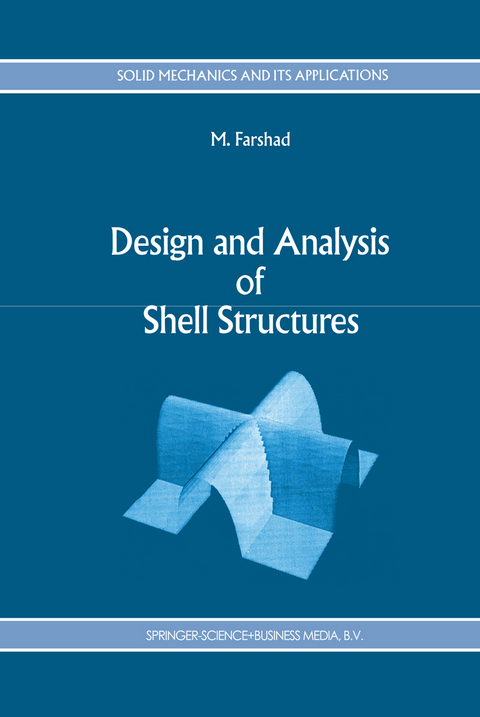
Design and Analysis of Shell Structures
Seiten
2010
|
Softcover reprint of hardcover 1st ed. 1992
Springer (Verlag)
978-90-481-4200-2 (ISBN)
Springer (Verlag)
978-90-481-4200-2 (ISBN)
Shell structures are widely used in the fields of civil, mechanical, architectural, aeronautical, and marine engineering. Shell technology has been enhanced by the development of new materials and prefabrication schemes. Despite the mechanical advantages and aesthetic value offered by shell structures, many engineers and architects are relatively unacquinted with shell behaviour and design.
This book familiarizes the engineering and architectural student, as well as the practicing engineer and architect, with the behaviour and design aspects of shell structures. Three aspects are presented: the Physical behaviour, the structural analysis, and the design of shells in a simple, integrated, and yet concise fashion. Thus, the book contains three major aspects of shell engineering: (1) physical understanding of shell behaviour; (2) use of applied shell theories; and (3) development of design methodologies together with shell design examples.
The theoretical tools required for rational analysis of shells are kept at a modest level to give a sound grasp of the fundamentals of shell behaviour and, at the same time, an understanding of the related theory, allowing it to be applied to actual design problems. To achieve a physical understanding of complex shell behaviour, quantitative presentations are supplemented by qualitative discussions so that the reader can grasp the `physical feeling' of shell behaviour. A number of analysis and detailed design examples are also worked out in various chapters, making the book a useful reference manual.
This book can be used as a textbook and/or a reference book in undergraduate as well as graduate university courses in the fields of civil, mechanical, architectural, aeronautical, and materials engineering. It can also be used as a reference and design-analysis manual for the practicing engineers and architects. The text is supplemented by a number of appendices containing tables of shellanalysis and design charts and tables.
This book familiarizes the engineering and architectural student, as well as the practicing engineer and architect, with the behaviour and design aspects of shell structures. Three aspects are presented: the Physical behaviour, the structural analysis, and the design of shells in a simple, integrated, and yet concise fashion. Thus, the book contains three major aspects of shell engineering: (1) physical understanding of shell behaviour; (2) use of applied shell theories; and (3) development of design methodologies together with shell design examples.
The theoretical tools required for rational analysis of shells are kept at a modest level to give a sound grasp of the fundamentals of shell behaviour and, at the same time, an understanding of the related theory, allowing it to be applied to actual design problems. To achieve a physical understanding of complex shell behaviour, quantitative presentations are supplemented by qualitative discussions so that the reader can grasp the `physical feeling' of shell behaviour. A number of analysis and detailed design examples are also worked out in various chapters, making the book a useful reference manual.
This book can be used as a textbook and/or a reference book in undergraduate as well as graduate university courses in the fields of civil, mechanical, architectural, aeronautical, and materials engineering. It can also be used as a reference and design-analysis manual for the practicing engineers and architects. The text is supplemented by a number of appendices containing tables of shellanalysis and design charts and tables.
1 — Introduction to Shells.- 2 — Preliminaries of Shell Analysis and Design.- 3 — Membrane Behavior of Cylindrical Shells.- 4 — Bending Analysis of Circular Cylindrical Shells.- 5 — Design of Concrete Cylindrical Shell Roofs.- 6 — Membrane Analysis of Shells of Revolution.- 7 — Bending Analysis of Axisymmetric Shells.- 8 — Design of Reinforced Concrete Domes.- 9 — Analysis of Shells with Arbitrary Geometry.- 10 — Design of Hyperbolic Paraboloid Shells.- 11 — Analysis and Design of Folded Plates.- 12 — Design of Liquid Retaining Shells.- 13 — Buckling of Shells.- Appendixes.- Appendix A — Formulas for the Membrane Field in Shells.- Appendix B -Tables For Analysis of Circular Cylindrical Shell Roofs.
| Erscheint lt. Verlag | 3.12.2010 |
|---|---|
| Reihe/Serie | Solid Mechanics and Its Applications ; 16 |
| Zusatzinfo | XII, 424 p. |
| Verlagsort | Dordrecht |
| Sprache | englisch |
| Maße | 155 x 235 mm |
| Themenwelt | Naturwissenschaften ► Physik / Astronomie ► Mechanik |
| Technik ► Bauwesen | |
| Technik ► Fahrzeugbau / Schiffbau | |
| Technik ► Maschinenbau | |
| ISBN-10 | 90-481-4200-8 / 9048142008 |
| ISBN-13 | 978-90-481-4200-2 / 9789048142002 |
| Zustand | Neuware |
| Haben Sie eine Frage zum Produkt? |
Mehr entdecken
aus dem Bereich
aus dem Bereich
Statik - Kinematik - Kinetik - Schwingungen - Festigkeitslehre
Buch | Hardcover (2021)
Hanser, Carl (Verlag)
CHF 41,95


